 |
La Voce del Padrone mod. 570
"Sintorapida" Italy - 1941 |
 |
|
|
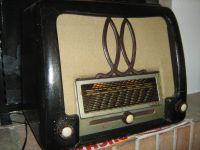
|
|
|
|
|
|||
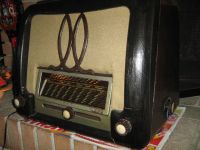 |
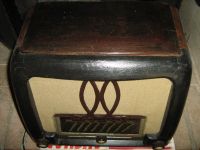 |
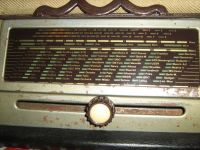 |
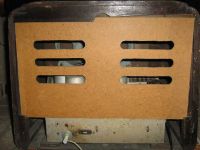 |
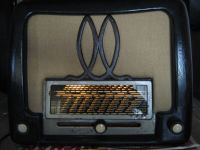 |
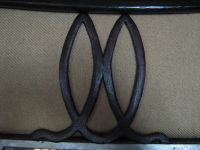 |
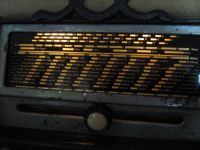 |
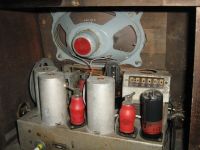 |
 La Voce del Padrone mod. 570 "Sintorapida" - Milano, Italia
- 1941.
La Voce del Padrone mod. 570 "Sintorapida" - Milano, Italia
- 1941.La 570 utilizzava 5 valvole della serie europea: la ECH4 come convertitrice, la EF9 nel circuito di Frequenza Intermedia, la EBC3 come preamplificatore e la EL3 come finale di BF. Come raddrizzatrice veniva utilizzata la 5Y3GR con zoccolo octal. Lo stadio di Frequenza Intermedia risuonava a 465 kHz. La radio era stata denominata "Sintorapida" perché utilizzava un sistema meccanico con un pomello che scorreva su una lunga barra d'acciaio e un sistema di fili d'acciaio e di carrucole poste sotto la scala parlante che permettevano una veloce rotazione del condensatore variabile e di conseguenza una sintonizzazione rapida della radio. La manopola del cambio gamma era sul fianco destro del mobile, mentre i comandi di volume e quello demoltiplicato della sintonia erano situati negli angoli in basso dl frontale del mobile. Nel pannello posteriore della 570 c'erano la presa d'antenna, quella di terra e la presa fono. Il mobile era di legno con un fregio artistico nel frontale che proteggeva l'altoparlante ovale del tipo elettrodinamico. La scala parlante era in vetro ed era retro-illuminata da due lampadine tipo E10 da 6,3 V 300 mA. L'alimentazione avveniva tramite rete elettrica da 110; 130; 145; 160; 220 o 275 Vac. Le dimensioni erano: 46 x 37 x 30 cm, e il peso era di 12 kg. Restauro: L'esemplare di 570 che ho trovato era in pessime condizioni: il fregio anteriore mancava, l'altoparlante era privo dell'avvolgimento elettromagnetico, la scala parlante non era quella originale, durante il trasporto si erano fracassate la valvola EL3 e una manopola e inoltre altri guasti erano presenti del circuito. L'altoparlante l'ho sostituito con un magnetodinamico ovale da 4 Ohm, di dimensioni uguali all'originale, e al posto dell'avvolgimento di campo ho usato due grosse resistenze da 10 W poste in serie, una da 1500 e una da 190 Ohm, per un totale di 1690 Ohm. La EL3, vecchio e raro pentodo di potenza audio invece l'ho dovuta acquistare. Dopo aver sostituito i condensatori elettrolitici CE48, CE49, CE52 e riparato alcuni guasti sul circuito, ho riassemblato la manopola fracassata con la colla epossidica e rifatto il fregio mancante ritagliandolo con il seghetto da traforo da una sottile tavoletta di legno. Qualche colpo di lima e un paio di mani di vernice marrone scuro hanno concluso il restauro della vecchia radio dell'inizio degli anni '40. IK3HIA © 2009. |
|||
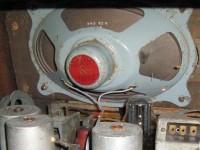 |
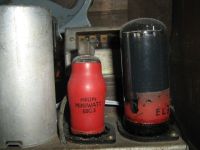 |
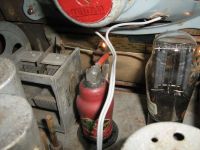 |
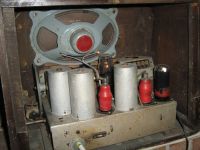 |
 |
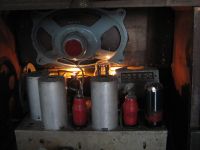 |
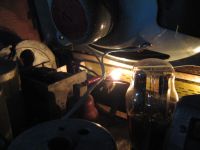 |
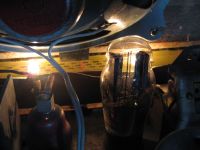 |
 La Voce del
Padrone mod. 570 "Sintorapida" - Milan, Italy - 1941.
La Voce del
Padrone mod. 570 "Sintorapida" - Milan, Italy - 1941.The 570 used 5 tubes of the European series: the ECH4 as a converter, the EF9 in the Intermediate Frequency circuit, the EBC3 as a preamplifier and the EL3 as a BF power amp. The 5Y3GR with octal socket was used as a rectifier. The Intermediate Frequency stage resonated at 465 kHz. The radio was called "Sintorapida" because it used a mechanical system with a knob that slid on a long steel bar and a system of steel wires and pulleys placed under the dial that allowed a fast rotation of the variable capacitor and consequently a quick tuning of the radio. The range change knob was on the right side of the cabinet, while the volume controls and the demultiplied tuning control were located in the lower corners of the front of the cabinet. On the rear panel of the 570 there were the antenna socket, the ground socket and the phono socket. The cabinet was made of wood with an artistic frieze on the front that protected the oval electrodynamic speaker. The dial was made of glass and was backlit by two E10 type bulbs of 6.3 V 300 mA. The power supply was via mains 110; 130; 145; 160; 220 or 275 Vac. The dimensions were: 18.1 x 14.6 x 11.8 inch, and the weight was 26 lb 6.9 oz. Restoration: The 570 I found was in terrible condition: the front decoration was missing, the speaker was missing the electromagnetic winding, the dial was not the original one, the EL3 valve and a knob had been smashed during transport and there were other faults in the circuit. I replaced the speaker with a 4 Ohm oval magnetodynamic, the same size as the original, and instead of the field winding I used two big 10 W resistors in series, one 1500 and one 190 Ohm, for a total of 1690 Ohm. Instead I had to buy the rare EL3, an old audio power pentode. After replacing the CE48, CE49, CE52 electrolytic capacitors and repairing some faults on the circuit, I reassembled the smashed knob with epoxy glue and redid the missing decoration by cutting it out with a jigsaw from a thin wooden board. A few strokes of the file and a couple of coats of dark brown paint completed the restoration of the old radio from the early 1940s. IK3HIA © 2009. |
|||
|
|
|||
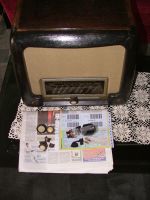 |
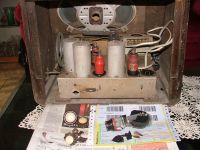 |
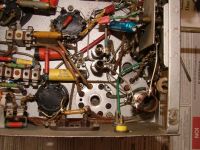 |
 |
 |
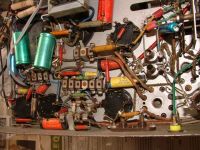 |
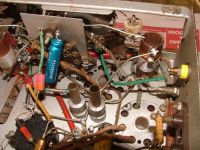 |
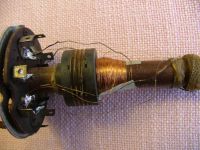 |
 |
 |
 |
|
|
Back to top of page
|
|||
| Return to: ik3hia home page |
|
Back to: old tube radio |